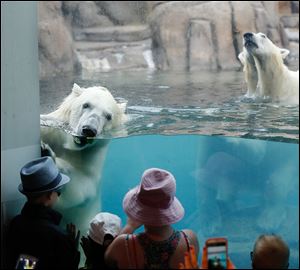
Polar bear cubs leave Toledo
Siblings shifted to Minnesota to ensure genetic diversity
8/22/2014
Visitors to the Toledo Zoo view young twin polar bears Sakari and Suka, during feeding time Thursday.
The Toledo Zoo’s two juvenile polar bears will soon be moving on to their next home.
The zoo announced Thursday that brother and sister Sakari and Suka, born to mother Crystal and father Marty in November, 2012, will leave Toledo in the fall.
Andi Norman, director of public relations for the zoo, said visitors have enjoyed watching the bears grow since they were put on exhibit in May, 2013.
“Seeing them grow up, that has an impact on people,” she said. “They’re so active and playful. They are right up at the glass. It’s been an incredible opportunity for people to have these experiences with them.”
But now, she said, it’s time for them to move on and entertain crowds somewhere else.
The bears are going together to the Como Park Zoo and Conservatory in St. Paul, though a specific timeline for the move is still being worked out.
“That’s always nice when you can transfer two together, especially when they are young,” said Dr. Randi Meyerson, zoo assistant director of animal programs.
Dr. Meyerson coordinates the Association of Zoos and Aquariums’ Polar Bear Species Survival Plan, which recommends breeding pairs and animal transfers to ensure genetic diversity. She also serves on Polar Bear International’s advisory council and said Sakari and Suka will be in good hands as their next home has polar bears now.
“I have a lot of confidence in them,” she said. “It’s a good start to their future.”
The Toledo Zoo’s two adult females, Crystal and Nanuyaak, and male, Marty, will stay behind. Dr. Meyerson said there are successful breeding pairs of polar bears in the United States, and the Toledo bears have successfully reared eight cubs in the last six years.
“We hope to continue breeding our adults and sharing the offspring,” she said.
Toledo might not be without young polar bears for long. Nanuyaak mated with Marty in the spring, though because polar bear embryos have a delayed implantation, the zoo won’t know if she is pregnant until the fall by observing her behavior when she’s ready to spend time in a den. If she is pregnant, she will stop eating and stay in the den longer to give birth and care for her young.
“We’ve been really fortunate here in Toledo,” Dr. Meyerson said. “We’re hopeful we will be again.”
In the meantime, the zoo will take the bears off exhibit for a time in the fall to repair damage to the decorative rock caused by the harsh winter and the rambunctious youngsters.
Dr. Meyerson said the species survival plan has issued breeding recommendations for both Nanuyaak and Crystal with Marty. Breeding season is usually late February through early May.
If Nanuyaak does not have cubs, she may mate again. The zoo is unsure whether Crystal will be ready to breed this spring since she has had the two cubs with her and may not cycle back this season.
Contact Alexandra Mester: amester@theblade.com, 419-724-6066, or on Twitter @AlexMesterBlade.